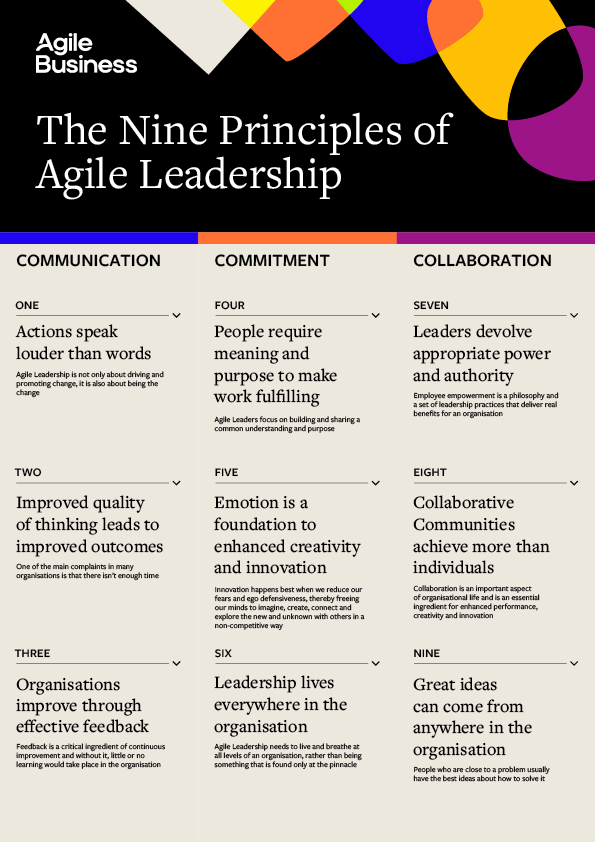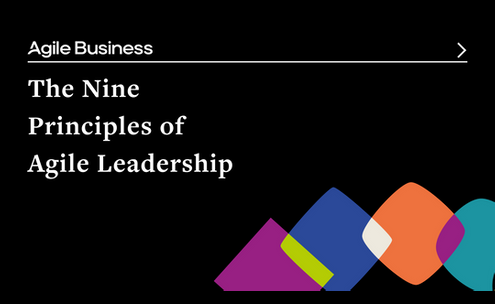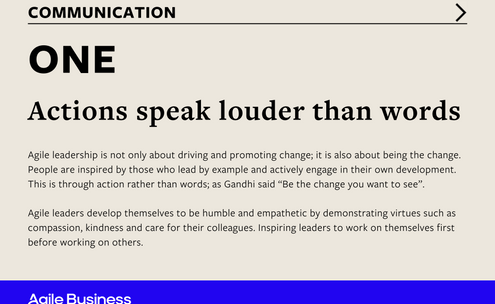The Nine Principles of Agile Leadership
Introduction
Agile leadership is essential if an organisation is to effect true agile business change. Our first paper on culture and leadership explained how the concepts of communication, commitment and collaboration were key; now the Agile Business Consortium has developed these concepts further with “The Nine Principles of Agile Leadership” that support agile transformations.
This table shows how the nine principles align with the key concepts of communication, commitment and collaboration:
The 3 C’s |
Principle |
Guidance |
|
Communication |
1 | Developing |
| 2 | Reflecting | |
| 3 | Learning | |
|
Commitment |
4 | Inspiring |
| 5 | Engaging | |
| 6 | Unifying | |
|
Collaboration |
7 | Empowering |
| 8 | Achieving | |
| 9 | Innovating |
Agile leadership versus good leadership
In creating these principles, we sought to identify the competencies, capabilities and capacities of an agile leader. The purpose is to guide the thinking of our user audience by helping them to discuss what agile leadership means in the context of their organisation. Many of our readers may think that agile leadership is just “good leadership”, and we have just added ”agile”. We believe that this is not the case and that agile leadership feels very different to, say, traditional leadership. The differences are in leadership style and the willingness to expand capacity and extend capabilities to be more agile. This also feels very different to leadership where leaders are going through the motions of just doing agile because of some wider directive.
We believe agile leadership is more than just “good leadership”; we would argue that it is “great leadership” that gets better!
Agile leadership as a continuum
An agile mindset does not see things in a polarised view, i.e. agile or not. Agility is not an all or nothing quality but instead should be considered on a continuum. The agile leader is one who adapts, yet there are many good leaders in organisations who rarely adapt. Some leaders have a command and control style of leadership, but that is not to say they are bad leaders. However, many of these leaders find it harder than others to adapt because of their mindset (see principle 1). Agile leadership is something that varies and improves over time. We feel the principles go some way to describing what we consider agile leadership. We have tested these principles with a wide audience of leaders and practitioners and they have assured us that while considered to be an evolving set of principles, they are a useful start for any senior executive or manager engaging in the work of transforming their organisation into an agile one.
The Nine Principles of Agile Leadership
Principle 1 - Actions speak louder than words
Agile leadership is about not only driving and promoting change, it is also about being the change. Those who lead by example and actively engage in their own development, inspire people. This is through action rather than words; as Gandhi said, “Be the change you want to see”. Agile Leaders develop themselves to be humble and empathetic by demonstrating virtues such as compassion, kindness and care for their colleagues. Inspiring leaders work on themselves first before working on others.
Principle 2 - Improved quality of thinking leads to improved outcomes
Agile leaders value high quality thinking which will result in meaningful action. Agile leaders view problems from many different angles. They take input from those closest to the problem and this goes some way to ensuring that they are in touch with reality rather than relying solely on electronic information to inform their decision making. This also means allowing thinking time and focusing on the highest priorities at any given time.
Principle 3 - Organisations improve through effective feedback
Receiving feedback can often be perceived as a negative experience, so Agile Leaders lead the way by courageously soliciting meaningful, useful and timely feedback from peers and other colleagues. While requesting feedback is important, agile leaders take time to ensure that they are visibly responding to the suggestions made by their colleagues in order to close the feedback loop. Agile leaders model giving effective feedback that is open, honest and respectful.
Principle 4 - People require meaning and purpose to make work fulfilling
Agile leaders focus on building and sharing a common understanding and purpose. There is a vision of change that is meaningful and applicable to the organisation. The work of the agile leader is to be aware of what is in the hearts and minds of their colleagues, and then to unify and align those values into inspired action.
Principle 5 - Emotion is a foundation to enhanced creativity and innovation
Agile leaders inspire others to bring their best selves to their work. They understand that emotion is an important part of the human experience, and when individuals work with their emotions, they achieve more of their potential. Innovation and creativity rely heavily on respect that the agile leader encourages by being accessible, open, honest and transparent whilst expecting the same from others.
Principle 6 - Leadership lives everywhere in the organisation
Agile leadership should permeate all aspects of an organisation or change initiative. Realising the leadership potential of all its people helps accelerate the organisation’s ability to learn and adapt. The work of an agile leader is to develop depth in the organisation’s leadership capability by providing opportunities for their people to lead. Mentoring tomorrow’s leaders in the principles and practices of servant leadership sows the seeds for the agile culture to thrive.
Principle 7 - Leaders devolve appropriate power and authority
Agile leaders recognise that people work best when they are enabled, engaged and energised. Empowering individuals is a necessary skill of the agile leader as they balance the emerging needs and tensions of the organisation. Agile leaders recognise that empowerment is not an “all or nothing” concept. Instead, it is a continuum of leadership behaviour that responds to the current context for change.
Principle 8 - Collaborative communities achieve more than individuals
Agile leaders build communities based on high trust, respect and meaningful working relationships. Their role is to provide those communities with all that they need to operate efficiently but then to let them function autonomously within their boundaries. The Agile Leader understands that forgiveness, positivity, generosity and gratitude are important parts of a healthy working environment. The healthy functioning of the group together with the preservation of psychological safety, allows the agile leader to encourage learning and development whilst also balancing sustained output and performance for the benefit of the organisation.
Principle 9 - Great ideas can come from anywhere in the organisation
People who are close to a problem usually have the best ideas about how to solve it. Agile leaders allow themselves to be open to the influence and ideas of others, regardless of their status or position. To this end, the agile leader stops, listens and gives time to really hear the thoughts and ideas for improvement from their colleagues. Even if some ideas are not used, the agile leader encourages a continuous flow of creativity by helping people to understand which ideas were useful and which were not.

Your feedback is welcome
The work of the Agile Business Consortium is ongoing, and we always welcome feedback; the continued collaboration between user organisations and the Consortium will ensure we deliver the greatest value to our membership and the wider community.
Author

Agile Business Consortium
- Email:
- [email protected]
- Twitter:
- @Agile_Biz
- Website:
- www.agilebusiness.org
- LinkedIn:
- https://linkedin.com/company/agile-business-consortium



